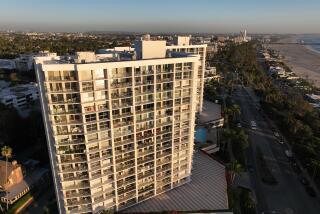When Board Is Run Like ‘Secret Society’
- Share via
QUESTION: The board of directors at our large condominium complex seems to think they are running a secret society. Owners are allowed to come to the monthly meetings and make comments and suggestions. Then the board adjourns to a closed session to make all their decisions.
At a recent annual meeting, none of the board members would explain several proposed amendments to our legal documents. No discussion was allowed. Of course, when the vote was taken, none of the amendments were approved.
My belief is that most of the owners feel disenfranchised or just plain angry with the board. How can board members be persuaded that open meetings and open communication is in their best interest?
Is there any legal requirement regarding open meetings and published minutes?
ANSWER: I believe the owners are entitled to know how their directors are voting on the policies and issues that face the association. I agree that open communication will benefit both the board and the owners.
Some boards feel threatened by any input from the rest of the owners, or they feel that their decisions should always be unanimous in order to present a united front. This can lead to an “us against them” syndrome.
In California, there is no legal requirement that community association boards have open meetings. Several other states, such as Florida, Illinois, Hawaii and Maryland, require open meetings except in limited circumstances.
I have seen some association bylaws that specifically require open meetings. Check your own association’s legal documents to see what your bylaws require.
In general, the more openly that the board can conduct the business affairs of the association, the less the owners will question their decisions and their motives. If minutes of meetings are not distributed to the general membership, the minutes should be made available to all members who request them.
Procedures in CC&Rs; for Annual Meetings
Q: I am serving on the board of directors of our 44-unit homeowners association. It has been over a year since our last annual meeting. I was appointed to fill out another board member’s term and no one seems to know what was done to organize the last annual meeting. The board president has lost interest and is out of town most of the time.
What should the board be doing to schedule and organize our annual meeting?
A: I assume that your association has no management company or you would have already asked the manager for assistance.
Read your association’s declaration of covenants, conditions and restrictions (CC&Rs;) and the bylaws. The CC&Rs; usually establish that annual meetings are required. The bylaws will spell out the location, date and the notice requirements, quorum requirements, and proxy provisions. The bylaws may even provide the agenda or “order of business.”
Use the bylaws as your guide. To prepare for the annual meeting, the board should direct the secretary to send a Notice of Meeting to all the recorded owners. The notice should include a proxy form and the meeting agenda. Any issues that will be voted upon by the members should be noted on the agenda.
When the meeting takes place, members should sign in on a registration sheet that lists all record owners. If you do not have a quorum, the meeting must be adjourned to another date or rescheduled.
The president or secretary should bring the CC&Rs; and bylaws to the meeting for reference, if needed. The minutes of the previous annual meeting should be available for approval. The secretary should take minutes to show that a quorum was present and record any votes or action taken by the membership.
Ballots should be used for the voting. Some association bylaws state that secret written ballots shall be used. It is usually permissible to allow a voice vote when the number of nominees equals the number of open positions on the board.
The main purpose of the meeting is to elect directors. Many associations discuss financial conditions or budgets at this time, but that is not the major purpose of the meeting since it is the board’s responsibility to adopt the budget and oversee the finances.
After the election has taken place and the general membership meeting is adjourned, the directors meet for their election of officers. In other words, the members do not vote for certain individuals for president, vice president and so on. The person who gets the largest number of votes does not automatically become president.
Even in a small association, annual meetings and elections should be carefully conducted in compliance with the governing documents. If you have a question about procedures, contact an association management consultant or an attorney who specializes in community association law.
Hickenbottom is past president of the Greater Los Angeles chapter of the Community Associations Institute (CAI), a national nonprofit research and educational organization. She welcomes readers’ questions, but cannot answer them individually. Readers with questions or comments can write to her in care of “Condo Q&A;,” Box 5068, Thousand Oaks, Calif. 91360.


